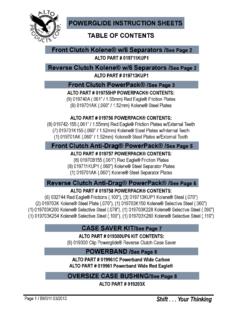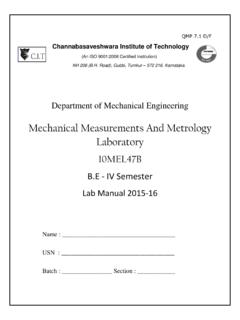Transcription of GCE Physics A - OCR
1 Oxford Cambridge and RSA Examinations GCE Physics A Unit H156/01: Breadth in Physics Advanced Subsidiary GCE Mark Scheme for June 2016 OCR (Oxford Cambridge and RSA) is a leading UK awarding body, providing a wide range of qualifications to meet the needs of candidates of all ages and abilities. OCR qualifications include AS/A Levels, Diplomas, GCSEs, Cambridge Nationals, Cambridge Technicals, Functional Skills, Key Skills, Entry Level qualifications, NVQs and vocational qualifications in areas such as IT, business, languages, teaching/training, administration and secretarial skills. It is also responsible for developing new specifications to meet national requirements and the needs of students and teachers.
2 OCR is a not-for-profit organisation; any surplus made is invested back into the establishment to help towards the development of qualifications and support, which keep pace with the changing needs of today s society. This mark scheme is published as an aid to teachers and students, to indicate the requirements of the examination. It shows the basis on which marks were awarded by examiners. It does not indicate the details of the discussions which took place at an examiners meeting before marking commenced. All examiners are instructed that alternative correct answers and unexpected approaches in candidates scripts must be given marks that fairly reflect the relevant knowledge and skills demonstrated.
3 Mark schemes should be read in conjunction with the published question papers and the report on the examination. OCR will not enter into any discussion or correspondence in connection with this mark scheme. OCR 2016 H156/01 Mark Scheme June 2016 3 Annotations available in RM Assessor Annotation Meaning Benefit of doubt given Contradiction Incorrect response Error carried forward Level 1 Level 2 Level 3 Transcription error Benefit of doubt not given Power of 10 error Omission mark Error in number of significant figures Correct response Wrong Physics or equation H156/01 Mark Scheme June 2016 4 Abbreviations, annotations and conventions used in the detailed Mark Scheme (to include abbreviations and subject-specific conventions).
4 Annotation Meaning / alternative and acceptable answers for the same marking point reject Answers which are not worthy of credit not Answers which are not worthy of credit Ignore Statements which are irrelevant Allow Answers that can be accepted ( ) Words which are not essential to gain credit __ Underlined words must be present in answer to score a mark ECF Error carried forward AW Alternative wording ORA Or reverse argument H156/01 Mark Scheme June 2016 5 CATEGORISATION OF MARKS The marking schemes categorise marks on the MACB scheme. B marks: These are awarded as independent marks, which do not depend on other marks. For a B-mark to be scored, the point to which it refers must be seen specifically in the candidate s answers.
5 C marks: These are compensatory method marks which can be scored even if the points to which they refer are not written down by the candidate, providing subsequent working gives evidence that they must have known it. For example, if an equation carries a C-mark and the candidate does not write down the actual equation but does correct working which shows the candidate knew the equation, then the C-mark is given. M marks: These are method marks upon which A-marks (accuracy marks) later depend. For an M-mark to be scored, the point to which it refers must be seen in the candidate s answers. If a candidate fails to score a particular M-mark, then none of the dependent A-marks can be scored. A marks: These are accuracy or answer marks, which either depend on an M-mark, or allow a C-mark to be scored.
6 Note about significant figures: If the data given in a question is to 2 sf, then allow to 2 or more significant figures. If an answer is given to fewer than 2 sf, then penalise once only in the entire paper. Any exception to this rule will be mentioned in the Guidance. H156/01 Mark Scheme June 2016 6 SECTION A Question Answer Marks Guidance 1 C 1 2 B 1 3 C 1 4 D 1 5 B 1 6 A 1 7 B 1 8 B 1 9 A 1 10 C 1 11 D 1 12 B 1 13 C 1 14 C 1 15 C 1 16 A 1 17 D 1 18 C 1 19 D 1 20 B 1 Total 20 H156/01 Mark Scheme June 2016 7 SECTION B Question Answer Marks Guidance 21 (a) Mass is a scalar (quantity) and velocity is a vector (quantity). (Addition of) velocity depends on direction / sign / vector triangle / resolving (ORA) B1 B1 Allow Velocity can be cancelled out (b) (i) An arrow from trolley to ramp along the string (for the tension) and a downwards arrow from the trolley (for the weight).
7 B1 Allow arrows in correct directions anywhere on Fig. 21 Not arrow for the tension parallel to the ramp Not arrow perpendicular to the ramp for the weight Not two arrow heads in opposite directions along the string for the tension (ii) (s = at2); = t2 (Any subject) t = (s) C1 A1 Note: Apply SF penalty if s is on the answer line or the final answer Allow 1 mark for (s); m s-2 used instead of m s-2 Allow full credit for alternative methods, : v2 = 2 ; v = (m s-1) t = C1 t = (s) A1 Total 5 H156/01 Mark Scheme June 2016 8 Question Answer Marks Guidance 22 (a) The gradient remains the same B1 Note: This mark is for the idea that the gradient / slope (of the line) remains the same Allow: The line is (just) shifted (to the right) by the same amount (AW) (b) Gradient determined from Fig.
8 22 and gradient = 16 gradient = 2a (F = ma); F = 920 F = 103 (N) C1 C1 A1 Allow for the value of the gradient Not u2/x value using the line or a data point because the gradient is not determined Allow this mark even if gradient = a Possible ECF for this A1 mark if the gradient is determined but its value is outside the range to and the second C1 mark has also been scored Note: The answer to 3 SF is 7360 (N) Note: F = 920 16 = 14720 (N) can score the first C1 mark Total 4 H156/01 Mark Scheme June 2016 9 Question Answer Marks Guidance 23 (a) pressure = areacylinder) (of weight Weight (of cylinder) determined using a newtonmeter or Measure mass (of cylinder) using balance / scale(s) and multiplying by g / (1 m s-2) Area determined by measuring the diameter with a ruler / vernier callipers / micrometer and then using (area =) r2 A sensible suggestion that reduces the % uncertainty: Use micrometer / (vernier) calipers / travelling microscope Use balance / newtonmeter with smaller division (AW) B1 B1 B1 B1 Note.
9 In this question any symbols used must be defined or previously mentioned Note: Allow full credit for alternative methods, using the equation pressure = height density g Allow force/area Not gravity for g Not measure radius Allow other correct methods Not repeat readings (of diameter etc.) because this procedure improves the accuracy and not the precision Allow balance / newtonmeter with high resolution (b) (i) The upthrust is equal to the weight of the fluid / liquid / water / air displaced B1 (ii) (upthrust =) (N) or (mass =) (1) V = 1000) ( or V = (23) 10-4 (m3) = ) ( = 103 (kg m-3) C1 C1 A1 Note: This C1 mark for determining the upthrust ( N) or the mass ( kg) of the cylinder Allow full credit for alternative methods.
10 = (kg m-3) Total 8 H156/01 Mark Scheme June 2016 10 Question Answer Marks Guidance 24 (a) (Resultant) force is (directly) proportional / equal to the rate of change of momentum B1 Not force = mass acceleration Not force change in momentum over time (b) (i) Any two from: momentum, (total) energy and mass B1 Not: kinetic energy (ii) The force will have the same magnitude (at any time t) The force is in the opposite direction / has negative value B1 B1 Not This is because action = reaction Not Newton s third law Allow 1 mark for a correct graph if there is no description or explanation (c) Method 1: Momentum is conserved 10-27 500 or 10-27 (-) 420 or 10-26 v 10-27 500 = 10-27 -420 + 10-26 v v = 78 (m s-1) Method 2: Kinetic energy is conserved 10-27 5002 or 10-27 4202 or 10-26 v2 10-27 5002 = 10-27 4202 + 10-26 v2 v = 79 (m s-1) C1 C1 A1 C1 C1 A1 Allow 1 mark for (m s-1).














